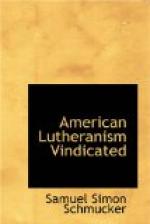In order that we may give this question an impartial and conscientious investigation, let us first inquire into the meaning of the word mass among the Papists, apart from the present dispute. “Mass (missa, Mess,) says Fuhrmann, in his Lexicon of Religious and Ecclesiastical History, [Note 5] at first signified that worship of God, which preceded the celebration of the Lord’s Supper. Subsequently, and especially in the fifth century, ministers termed the public celebration of the eucharist, mass (or missa, dismissed); because this service took place after the catechumens were dismissed. This word ‘missa’ was gradually corrupted into mass. But how did that mode of celebrating this ordinance arise in the Romish Church, which consisted in the priest’s giving the sacrament to himself alone, connected with solemn turnings around, and moving about from place to place, and changes of attitude, resembling in some degree a theatrical exhibition, which is termed mass?” He then proceeds to explain the history of the Romish mass here defined.
Siegel, in his excellent Manual of Christian Ecclesiastical Antiquities, published at Leipsic, in 1837, in four volumes, presents an extended view of this subject, from which we will extract little more than his definition of the mass. “The mass, in the Roman Catholic sense of the term, belongs not to the centuries of Christian antiquity, but to a later period.” [Note 6] We take up the subject at the time when the Catholic doctrine of transubstantiation was fully developed, (since the Lateran Council of 1215.) In conformity to this view of the sacrament, (the doctrine of transubstantiation,) the idea of the mass was so developed, as to signify that solemn act of the priest, decorated with many ceremonies, by which he offers the unbloody sacrifice at the altar.”




